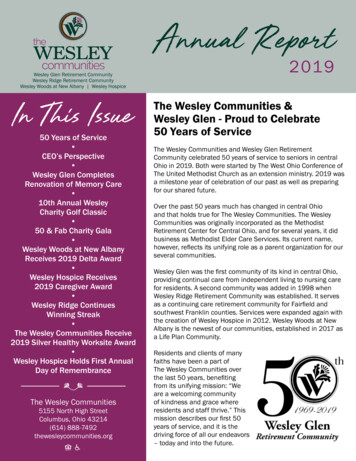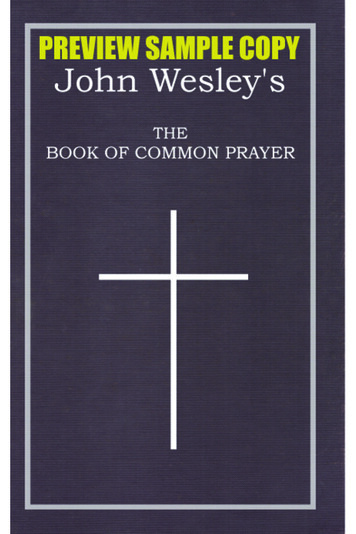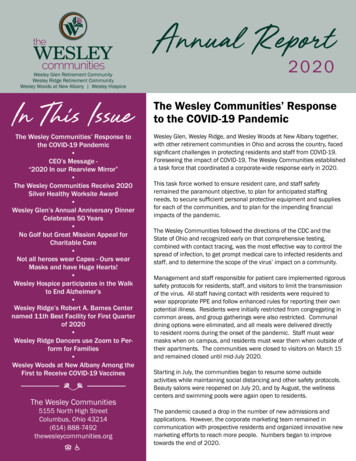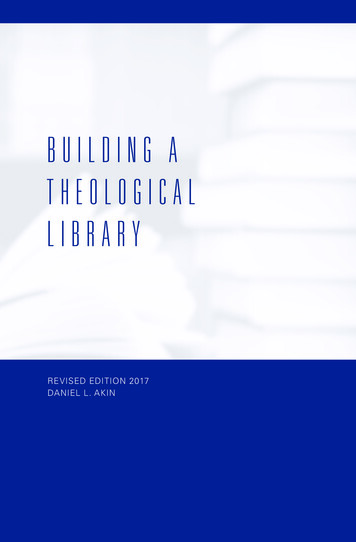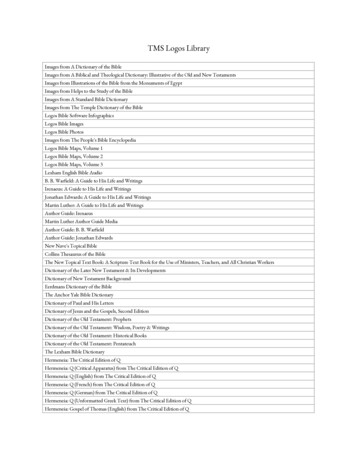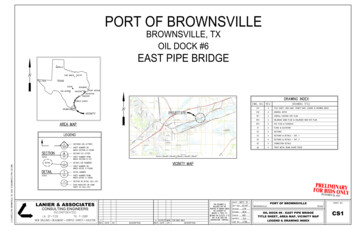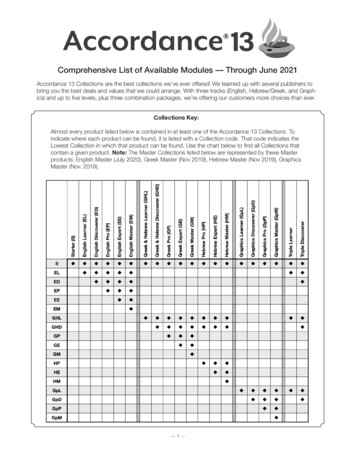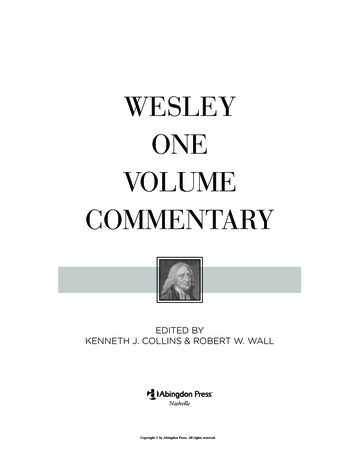
Transcription
WESLEYONEVOLUMECOMMENTARYEDITED BYKENNETH J. COLLINS & ROBERT W. WALLNashvilleCopyright by Abingdon Press. All rights reserved.9781501823916 INT TMP.indd14064-WesleyOne Volume Commentary frontmatter.indd3312/5/182/25/20 11:222:48 PMAM
Wesley One Volume CommentaryCopyright 2020 by Abingdon PressAll rights reserved.No part of this work may be reproduced or transmitted in any form or by any means, electronic ormechanical, including photocopying and recording, or by any information storage or retrieval system,except as may be expressly permitted by the 1976 Copyright Act or in writing from the publisher.Requests for permission can be addressed to Permissions, The United Methodist Publishing House,2222 Rosa L. Parks Blvd., Nashville, TN, 37228-1306 or emailed to permissions@umpublishing.org.LCCN: 2020933861ISBN: 978-1-5018-2391-6Unless otherwise noted, Scripture quotations are taken from the Common English Bible.Copyright 2011 by the Common English Bible. All rights reserved. Used by permission.www.CommonEnglishBible.com.Scripture quotations marked NRSV are taken from the NEW REVISED STANDARD VERSIONof the Bible. Copyright 1989 by the Division of Christian Education of the National Council ofChurches of Christ in the USA. Used by permission. All rights reserved.20 21 22 23 24 25 26 27 28 29—10 9 8 7 6 5 4 3 2 1MANUFACTURED IN THE UNITED STATES OF AMERICACopyright by Abingdon Press. All rights reserved.14064-Wesley One Volume Commentary frontmatter.indd 42/25/20 2:48 PM
For Joel B. Green:faithful friend, respected colleague,and biblical scholar extraordinaireCopyright by Abingdon Press. All rights reserved.14064-Wesley One Volume Commentary frontmatter.indd 52/25/20 2:48 PM
Copyright by Abingdon Press. All rights reserved.14064-Wesley One Volume Commentary frontmatter.indd 62/25/20 2:48 PM
CONTENTSContributorsixIntroduction to a Wesleyan Theological OrientationxiiiIntroduction to Wesleyan Biblical InterpretationxxiAbbreviations and ExplanationsxxxiCommentary on the Books of the Old TestamentGenesisBill T. ArnoldExodusH. Junia Pokrifka371LeviticusBrent A. Strawn66NumbersMatthew Richard Schlimm90DeuteronomyBrian D. Russell111JoshuaJoseph Coleson144JudgesLee Roy Martin166RuthNina Henrichs-Tarasenkova1831-2 SamuelL. Daniel Hawk1901-2 KingsDrew S. Holland2161-2 ChroniclesStephen P. Riley237EzraRichard P. Thompson255NehemiahRichard P. Thompson263EstherKaren Strand Winslow273JobJames C. Howell280PsalmsLee Roy Martin304ProverbsJames C. Howell340EcclesiastesLarisa Levicheva-Joseph358Song of SongsBrent A. Strawn371IsaiahRickie D. Moore385JeremiahJoel R. Soza426LamentationsJoel R. Soza450EzekielTimothy M. Green457DanielDaniel D. Bunn Jr.482HoseaBrad E. Kelle499JoelDonald Ernest Burke509AmosDonald Ernest Burke514ObadiahCraig A. Vondergeest523JonahCraig A. Vondergeest526MicahCraig A. Vondergeest530NahumLaurie J. Braaten535HabakkukLaurie J. Braaten538viiCopyright by Abingdon Press. All rights reserved.14064-Wesley One Volume Commentary frontmatter.indd 72/25/20 2:48 PM
CONTENTSZephaniahHaggaiZechariahMalachiLaurie J. BraatenKristen Lee HelmsKristen Lee HelmsKristen Lee Helms544548551558Commentary on the Books of the New TestamentMatthewMarkLukeJohnActsRomans1 Corinthians2 1 Thessalonians2 Thessalonians1 Timothy2 TimothyTitusPhilemonHebrewsJames1 Peter2 Peter1 John2 John3 JohnJudeRevelationRoger L. HahnDavid Fenton SmithMary K. SchmittRichard E. CornellKevin L. AndersonPresian Renee BurroughsAndy JohnsonB. J. OropezaDavid A. deSilvaSuzanne NicholsonBrian D. RussellJoseph R. DongellDavid R. BauerDavid R. BauerKen SchenckNijay K. GuptaKen SchenckMitzi J. SmithRuth Anne ReeseDavid R. NienhuisAbson Prédestin JosephDavid McCabeRobert W. WallRobert W. WallRobert W. WallDavid McCabeDean ht by Abingdon Press. All rights reserved.14064-Wesley One Volume Commentary frontmatter.indd 82/25/20 2:48 PM
CONTRIBUTORSGeneral EditorsKenneth J. Collins, Ph.D.Professor of Historical Theology andWesley StudiesAsbury Theological SeminaryThe United Methodist ChurchRobert W. Wall, Ph.D.Paul T. Walls Professor of Scripture andWesleyan StudiesSeattle Pacific University and SeminaryThe Free Methodist ChurchContributorsKevin L. Anderson, Ph.D.Professor of Bible and TheologyAsbury UniversityThe Anglican Church in North AmericaActsPresian Renee Burroughs, Th.D.Assistant Professor of New TestamentUnited Theological SeminaryThe United Methodist ChurchRomansBill T. Arnold, Ph.D.Paul S. Amos Professor of Old TestamentInterpretationAsbury Theological SeminaryThe United Methodist ChurchGenesisJoseph Coleson, Ph.D.Professor of Old Testament, EmeritusNazarene Theological SeminaryThe Wesleyan ChurchJoshuaRichard E. Cornell, Ph.D.Associate Professor of Biblical StudiesSpring Arbor UniversityThe United Methodist ChurchJohnDavid R. Bauer, Ph.D.Beeson Professor of Inductive Biblical StudiesDean of the School of Biblical InterpretationAsbury Theological SeminaryThe Free Methodist Church1-2 ThessaloniansDavid A. deSilva, Ph.D.Trustees’ Distinguished Professor of NewTestament and GreekAshland Theological SeminaryThe United Methodist ChurchGalatiansL aurie J. Braaten, Ph.D.Professor of Biblical Studies, EmeritusJudson UniversityThe Church of the NazareneNahum, Habakkuk, ZephaniahDaniel D. Bunn Jr., Ph.D.Assistant Professor of Old TestamentOral Roberts UniversityThe United Methodist ChurchDanielJoseph R. Dongell, Ph.D.Professor of Biblical StudiesDirector of Greek StudiesAsbury Theological SeminaryThe Wesleyan ChurchColossiansDonald Ernest Burke, Ph.D.Professor of Biblical StudiesBooth University CollegeThe Salvation ArmyJoel, AmosDean Flemming, Ph.D.Professor of New TestamentMidAmerica Nazarene UniversityThe Church of the NazareneRevelationixCopyright by Abingdon Press. All rights reserved.14064-Wesley One Volume Commentary frontmatter.indd 92/25/20 2:48 PM
CONTRIBUTORSTimothy M. Green, Ph.D.Dean of the Millard Reed School of Theologyand Christian MissionProfessor of Old Testament Theology andLiteratureTrevecca Nazarene UniversityThe Church of the NazareneEzekielAndy Johnson, Ph.D.Professor of New TestamentNazarene Theological SeminaryThe Church of the Nazarene1 CorinthiansAbson Prédestin Joseph, Ph.D.Professor of New TestamentAcademic Dean of Wesley SeminaryIndiana Wesleyan UniversityThe Wesleyan Church1 PeterNijay K. Gupta, Ph.D.Associate Professor of New TestamentPortland Seminary, George Fox University2 TimothyBrad E. Kelle, Ph.D.Professor of Old Testament and HebrewPoint Loma Nazarene UniversityThe Church of the NazareneHoseaRoger L. Hahn, Ph.D.Professor of New TestamentWillard H. Taylor Chair of Biblical TheologyNazarene Theological SeminaryThe Church of the NazareneMatthewL arisa Levicheva-Joseph, Ph.D.Associate Professor of Biblical StudiesIndiana Wesleyan UniversityThe Wesleyan Church of RussiaEcclesiastesL. Daniel Hawk, Ph.D.Professor of Old Testament and HebrewAshland Theological SeminaryThe United Methodist Church1-2 SamuelLee Roy Martin, D.Th.Professor of the Old Testament and BiblicalLanguagesPentecostal Theological SeminaryThe Church of God (Cleveland)Judges, PsalmsNina Henrichs-Teresenkova, Ph.D.Instructor in TheologyUniversity of PortlandThe Church of God (Anderson)RuthDavid McCabe, Ph.D.Missionary Church Endowed Professor ofBiblical TheologyBethel UniversityThe United Methodist Church2 Peter, JudeKristen Lee Helms, Ph.D.Assistant Professor of Biblical StudiesRoberts Wesleyan CollegeThe United Methodist ChurchHaggai, Zechariah, MalachiDrew S. Holland, Ph.D.Associate PastorHuntsville First UMC, Huntsville, AlabamaThe United Methodist Church1-2 KingsRickie D. Moore, Ph.D.Professor of Old TestamentAssociate Dean of the School of ReligionLee UniversityThe Church of God (Cleveland)IsaiahJames C. Howell, Ph.D.Senior PastorMyers Park United Methodist ChurchThe United Methodist ChurchJob, ProverbsSuzanne Nicholson, Ph.D.Professor of Biblical StudiesMalone UniversityThe United Methodist ChurchEphesiansxCopyright by Abingdon Press. All rights reserved.14064-Wesley One Volume Commentary frontmatter.indd 102/25/20 2:48 PM
CONTRIBUTORSDavid R. Nienhuis, Ph.D.Professor of New Testament StudiesSeattle Pacific UniversityThe Episcopal ChurchJamesDavid Fenton Smith, Ph.D.Associate Professor of New Testament andBiblical LanguagesIndiana Wesleyan UniversityThe Wesleyan ChurchMarkB. J. Oropeza, Ph.D.Professor of Biblical and Religious StudiesAzusa Pacific UniversityThe Free Methodist Church2 CorinthiansMitzi J. Smith, Ph.D.J. Davison Philips Professor of New TestamentColumbia Theological SeminaryThe African Methodist Episcopal ChurchPhilemonH. Junia Pokrifka, Ph.D.General Director of Phos MinistriesExodusJoel R. Soza, D.Th.Professor of Old TestamentMalone UniversityThe Church of the BrethrenJeremiah, LamentationsRuth Anne Reese, Ph.D.Beeson Chair of New Testament StudiesAsbury Theological SeminaryThe Anglican Church in North AmericaHebrewsBrent A. Strawn, Ph.D.Professor of Old Testament and Professor of LawDuke UniversityThe United Methodist ChurchLeviticus, Song of SongsStephen P. Riley, Ph.D.Associate Professor of Old TestamentNorthwest Nazarene UniversityThe Church of the Nazarene1-2 ChroniclesRichard P. Thompson, Ph.D.Professor of New TestamentChair of the Department of Philosophy andReligionNorthwest Nazarene UniversityThe Church of the NazareneEzra, NehemiahBrian D. Russell, Ph.D.Professor of Biblical StudiesAsbury Theological Seminary (Orlando, Florida)The United Methodist ChurchDeuteronomy, PhilippiansCraig A. Vondergeest, Ph.D.Professor of ReligionPresbyterian CollegeThe United Methodist ChurchObadiah, Jonah, MicahKen Schenck, Ph.D.Professor of New TestamentDean of the School of Theology and MinistryIndiana Wesleyan UniversityThe Wesleyan Church1 Timothy, TitusK aren Strand Winslow, Ph.D.Professor of Biblical StudiesChair of the Department of Biblical andTheological StudiesAzusa Pacific Seminary of Azusa PacificUniversityThe Free Methodist ChurchEstherMatthew Richard Schlimm, Ph.D.Professor of Old TestamentUniversity of Dubuque Theological SeminaryThe United Methodist ChurchNumbersMary K. Schmitt, Ph.D. candidateAssistant Professor of Biblical StudiesTrevecca Nazarene UniversityThe Church of the NazareneLukexiCopyright by Abingdon Press. All rights reserved.14064-Wesley One Volume Commentary frontmatter.indd 112/25/20 2:48 PM
Copyright by Abingdon Press. All rights reserved.14064-Wesley One Volume Commentary frontmatter.indd 122/25/20 2:48 PM
INTRODUCTION TO A WESLEYANTHEOLOGICAL ORIENTATIONKenneth J. CollinsIf you have ever hiked into a large forest yourealize very quickly that it’s easy to get lost. Allthe trees look alike to you and the distinguishingcues from a shifting landscape may all be gone.It’s helpful then to have a compass or, better yet,a couple of guides with you who know wherethey’re going. The difficulty with forests, amongother things, is that you can quickly become disoriented in the foot path view when what youreally need to see is the helicopter view, the largerlandscape of which the forest is a part. The Biblewith its many authors and its sixty-six books, theentirety of which took over fifteen hundred yearsto write as well as to be recognized as sacredscripture, is like a vast and lush forest in a number of ways. For one thing, it’s helpful when reading Genesis, for example, a book of beginnings,to have the end in view, the book of Revelation, inwhich Jesus Christ is both celebrated and glorified at the consummation of things.This twofold love of God and neighbor, displayed in both the Old Testament and in the New,is the interpretive guide, the key, to sacred scripture. This means, for instance, that if we interpreta particular book of the Bible in a way that undermines the universal love of God and neighborthen we are quite simply wrong in our judgment.Sadly the Bible has been misinterpreted, misused,and even abused in the past by groups throughouthistory that evidently did not love their neighborsas themselves but instead diminished their worththrough interpretations that were frankly racistor that were developed along class, economic,cultural or even ethnic lines. The greatest storyever told in the hands of some became a greatlydiminished narrative.Augustine’s counsel is also valuable in thatit suggests the Bible is best read in the church,within the community of the faithful, a context that will help to correct troubled and idiosyncratic views that are neither held nor evenacknowledged by the community, the theologicaltradition of which one is a part. This means then,contrary to some popular stereotypes, that no oneactually reads the Bible all alone, that is, utterlydivorced from the particular theological tradition, along with its interpretive commitments, inwhich one participates. Instead, the communityforms the interpretive context in which all reading takes place whether that community is fullyrecognized or not. Thus within the parametersof Augustine’s guide for reading the Bible therecan yet be a diversity of views as reflected, forexample, in the distinct theological traditionsthat have emerged in Christian history. That is,Roman Catholics read the Bible as Roman Catholics and Wesleyans as Wesleyans. Different theological traditions are in a real sense interpretivecommunities whose judgments are passed alongfrom age to age. Augustine’s guidance then doesnot result in an utter sameness of interpretationbut is able to embrace a number of readings,reflected in various traditions, that yet affirm theoverriding importance of the love of God andneighbor.Throughout history the Bible has been interpreted in numerous ways, some of which actuallycontradict one another. How would you knowthen that the interpretation you hold is correct,appropriate, or even edifying? This is the veryquestion that Augustine (354–430), early Christian theologian and philosopher, addressed inhis brief, yet very valuable, work On ChristianDoctrine. Taking the broadest view possible, thisLatin church father in effect posed the question,What’s the Bible all about? Put another way, heasked how scripture could be summarized in buta few words. These are queries not always entertained by people who see little beyond the footpath view, the details of a particular landscape.Augustine’s reply then is enormously valuablein that it gives readers a clear sense of orientation, the lay of the land so to speak, at the outset,whether they are in the book of 2 Chronicles orin the book of Galatians. Augustine expressed hisbasic interpretive principle in the following way:“Whoever, therefore, thinks that he understandsthe divine Scriptures or any part of them so that itdoes not build the double love of God and of ourneighbor does not understand it at all.”1xiiiCopyright by Abingdon Press. All rights reserved.14064-Wesley One Volume Commentary frontmatter.indd 132/25/20 2:48 PM
INTRODUCTION TO A WESLEYAN THEOLOGICAL ORIENTATIONJohn Wesley’sSummary of the Bible:Holiness and Gracelove could never be realized in practical Christian living.In many ways the practical theology of JohnWesley, richly informed by the Bible, resonateswith the universal teaching (catholic) of historicChristianity, or what C. S. Lewis in his own dayconsidered to be “mere Christianity.” In otherwords, Wesley’s reading of scripture, reflected inhis Old and New Testament Notes, for example,will be in accordance with the consensual tradition of the early church in both Christology andthe doctrine of the Trinity, for example. Thoughmuch is shared between the Wesleyan traditionand Roman Catholicism, Eastern Orthodoxyand Protestantism, the substance of which thelate Thomas C. Oden referred to as consensualChristianity, there are nevertheless importantdifferences, elements that Wesleyanism affirmsbut are not shared by all of the same three greattraditions just noted.Like Augustine, John Wesley thought carefully about the essential teaching of the Bible in hisown day and similarly concluded that it’s aboutlove, the love of God and neighbor. In fact, a datamining investigation of Wesley’s writings, conducted by Dr. Brint Montgomery, reveals that thesecond most prominent theme in all of his works(beyond God) is none other than love. Moreover,Wesley further delineates just what he means bythe term “love,” which our twenty-first-centurycontext so easily misunderstands, through theexpression “holy love,” which surfaced more thana dozen times in his writings.2 In other words, itis not just any love that is revealed in the Biblein general and in the humble sacrificial deathof Christ at Golgotha in particular. It is a lovemarked by the purity and simplicity of holiness.At Calvary nails could not destroy such a holylove, taunting could not weaken it, hatred couldnot overcome it.In this introduction then, for the sake of space,we will not consider all those doctrines of theWesleyan faith that are shared with the broaderChristian community such as the doctrine ofcreation along with its goodness, the fallennessof humanity, its sin and evil, and the doctrineof last things or eschatology, to name a few.Instead, we will focus on the emphases of theWesleyan theological tradition, ongoing elementsof its interpretive posture, that issue in a distinctvocabulary, conversation and life. In other words,we will explore what it means to “speak Wesleyan,” if you will, as a function of the ways thatbiblical scholars and theologians of the traditionhave not only interpreted scripture but have alsopassed along those various readings from generation to generation, a process that thereby creates adistinct Christian community that is empoweredto witness to the broader church. We will therefore offer a number of leading themes that makeup this Wesleyan witness.So then, if holy love aptly expresses the Christian understanding of God as revealed in boththe Old and New Testaments, then the beautyand strength of that love, as Wesley understoodso well, could only be communicated to a fallenhumanity through grace, both free (the work ofGod alone) and cooperant (divine and humancooperation). Not surprisingly then, Wesley’spractical theology, bathed in the language ofscripture, can be expressed quite simply in thewords holiness and grace, words that in turn areemblematic of the conjunctions of “holy/love”and of “free/cooperant” grace. In other words, ifholy love suitably describes the Christian Godhead, the very being of God, and if the two greatcommandments of loving God and neighbor epitomize the basic teaching of the Bible, then graceboth free and cooperant reveals just how thissacred deposit of holy love is both communicatedto and actualized in the lives of hitherto sinfulhuman beings. Simply put, holy love crossesthe separation between God and humanity onlythrough grace. And so to Augustine’s celebrationof the love of God and neighbor, Wesley adds inhis own practical theology the necessity of grace,both free and cooperant, apart from which suchGod Loves and Desiresto R edeem All PeopleGiven that the very nature of God is holy loveas expressed in the community of relations ofFather, Son and Spirit, Wesley maintains that theMost High cannot but will the greatest good forall of humanity that entails nothing less than axivCopyright by Abingdon Press. All rights reserved.14064-Wesley One Volume Commentary frontmatter.indd 142/25/20 2:48 PM
INTRODUCTION TO A WESLEYAN THEOLOGICAL ORIENTATIONdesire for their redemption. Again, God “wantsall people to be saved and to come to a knowledgeof the truth” (1 Tim 2:4), a passage upon whichWesley reflects: “It is strange that any whom hehas actually saved, should doubt the universalityof his grace.”3 Indeed, in commenting on John3:16, a passage that is emblematic of the universal love of God for all people (“God so loved theworld that he gave his only Son, so that everyonewho believes in him won’t perish but will haveeternal life” CEB), Wesley affirms a basic gospeltruth in his notes on this often-cited passage thatall people ought to believe “that Christ was givenfor them.” 4 Why then are not all people redeemeddespite the will of God to this end? Wesleyanswers this question forthrightly in his sermon,“Free Grace,” in which he replies, “[because]they will not be saved.” 5 In other words, “Soour Lord expressly [stated]: ‘They will not comeunto me that they may have life.’ ” 6 Simply put,God has made ample provision for the salvationof all people through the atoning work of Christbut many refuse to receive what is so graciouslyoffered.of all good, totally corrupted, since God sovereignly and in utter freedom restored the fourfaculties that together make up the deposit of prevenient grace, a grace that comes before salvationproperly speaking. These four faculties, given onthe basis of the illuminating work of Jesus Christ(as expressed in John 1:9), are as follows: conscience, a measure of freedom (to receive the further grace of God), knowledge of the moral law,and knowledge of the basic attributes of God.Prevenient grace, at the hands of God’s initiating work, marks the very beginning of redemptionin that it renders human beings accountable andresponsible and therefore savable. What’s more,it is given to all human beings; none are excludedfrom its embrace. Again, highlighting the favorand goodness of God in response to human sin,prevenient grace is given even before humanityhas realized it. Such grace, then, to use Wesley’sown words, “waiteth not for the call of man.” 8The larger theological significance of prevenientgrace, then, that will distinguish Wesleyan theology and interpretation from that of other traditions, is that although humanity cannot redeemitself, given the seriousness of sin, God will notredeem humanity without themselves, given theilluminating and enabling power of grace.God Gives PrevenientGrace to All PeopleHow Sin Is Defined IsCrucial in Understandingthe Liberties of R edemptionComing from the hands of the creator,humanity was both holy and good in this pristinestate. With unbelief arising in their hearts, Adamand Eve embraced a corruption of being, a selfcurvature or pride, that was subsequently manifested in sinful thoughts, words, and deeds. Thisnegative inheritance of sin and evil, an unholydeposit, was then passed along to the entiretyof humanity with the single exception of JesusChrist. Wesley employs a vocabulary similar toJohn Calvin’s to describe this wretched conditionapart from all grace: “Is man by nature filled withall manner of evil? Is he void of all good? Is hewholly fallen? Is his soul totally corrupted? Or,to come back to the text, is ‘every imagination ofthe thoughts of his heart evil continually’? Allowthis, and you are so far a Christian. Deny it, andyou are but a heathen still.”7Wesleyans and Calvinists can, and sometimesdo, talk past each other because it is not recognizedat the outset that they are operating out of different definitions of sin. For Calvinists any violationof a known law of God, whether willful or not, issin properly speaking. Such a definition seems toresonate with an Old Testament understanding asreflected in Levitical sacrifices for unintentionalsins. However, if such is the case, then how couldChristian believers ever be free from the power ordominion of sin as affirmed, for example, in bothRomans 6 and 8 and the First Letter of John? Itwould seem to be an impossibility simply becausefreedom from sins that are not intended wouldentail perfect performance, a clear impossibility.These NT books then would be left hanging in theair in terms of the application of their meaning.Wesley clearly recognized the issues at stake hereSo pervasive were the effects of sin onhumanity that if God did not act first to begin theprocess of redemption, then no human life couldbe saved. However, no human being was left voidxvCopyright by Abingdon Press. All rights reserved.14064-Wesley One Volume Commentary frontmatter.indd 152/25/20 2:48 PM
INTRODUCTION TO A WESLEYAN THEOLOGICAL ORIENTATIONin an important letter that he drafted in 1772 toMrs. Bennis that reads in part:wake of Vatican II, is that justification is distinctfrom sanctification. In other words, justificationentails not being made holy; that’s sanctification.That is, justification is “that great work whichGod does for us, in forgiving our sins.”13 Regeneration, or the new birth, is that “great work whichGod does in us, in renewing our fallen nature.” 14Nothing is sin, strictly speaking, but a voluntary transgression of a known law of God.Therefore every voluntary breach of the lawof love is sin; and nothing else, if we speakproperly. To strain the matter farther is onlyto make way for Calvinism. There may be tenthousand wandering thoughts and forgetfulintervals without any breach of love, thoughnot without transgressing the Adamic law.But Calvinists would fain confound thesetogether.9The confusion of the “for us” and “in us”nature of these works of grace (justification andregeneration) could only undermine the radicalPauline notion that God justifies not those whoare in any sense holy but the Almighty justifiessinners, the ungodly, those steeped in their sins.Even in his own day Wesley faced the complaintamong those to whom he had proclaimed the gospel that “I am not good enough to be forgiven.”His response to such an objection was quick andto the point: “Neither say in thy heart, ‘I cannotbe accepted yet, because I am not good enough.’Who is good enough—whoever was—to meritacceptance at God’s hands? Was ever any childof Adam good enough for this?”15 Elsewherein his journals, Wesley comforts sinners whowere overcome with their own sense of guilt andunworthiness: “Look for it [justification] just asyou are, unfit, unworthy, unholy, by simple faith,every day, every hour.”16 So then, justification,the forgiveness of those sins that are past is asheer gift, a species of free grace that could bereceived now. Simply put, sinners do not haveto clean themselves up first in order to be forgiven. The Apostle Paul knew this; Wesley knewit as well.Without this definition of sin, which is able tomake sense of the liberties proclaimed in Romansand the First Letter of John and elsewhere, readers of this commentary would be ill equipped tocomprehend the extent of divine grace highlighted by Wesley in his doctrines of both regeneration and entire sanctification.Justification Is Freedomfrom the Guilt of SinWesley defined justification quite simply asthe forgiveness of those sins that are past.10 Thatlast word, past, kept Wesleyan theology fromaffirming the mischievous notion that one couldbe justified in the ongoing practice of sin suchthat justification in effect would now be functioning as a license to sin. Elsewhere Wesley affirmedthat three things come together in justification:“Upon God’s part, his great mercy and grace;upon Christ’s part, the satisfaction of God’s justice, by the offering of his body, and shedding hisblood; and upon our part, true and living faith inthe merits of Jesus Christ.” 11Regeneration Is Freedomfrom the Power of SinIn his reading of scripture, Wesley clearlyrecognized that the liberties of the gospel are notexhausted in the proclamation of the forgivenessof sins. In fact, he taught that if the new birthdid not occur at the same time as justification,“you would immediately sin again, that is, unlessyour heart were cleansed; unless it were createdanew.” 17 Whereas in the reception of justifyinggrace one is freed from the guilt of sin, with theembrace of regenerating grace, one is set freefrom its power or dominion. However, not allChristian traditions have acknowledged such afreedom, due in some measure to different con-Wesley’s reading of scripture in terms of thedoctrine of justification shares much in commonwith the magisterial reformers Luther and Calvin. Indeed, in a letter to John Newton, drafted in1765, Wesley states: “I think on Justification justas I have done any time these seven-and-twentyyears, and just as Mr. Calvin does. In this respectI do not differ from him a hair’s breadth.” 12 WhatWesley and the Protestant reformers who preceded him saw so clearly, and what Roman Catholicism struggles to acknowledge even today in thexviCopyright by Abingdon Press. All rights reserved.14064-Wesley One Volume Commentary frontmatter.indd 162/25/20 2:48 PM
INTRODUCTION TO A WESLEYAN THEOLOGICAL ORIENTATIONceptions of sin—and of grace as well. For Wesley,regenerated believers are truly holy, not merelyreckoned to be so, simply because the Holy Spiritnow reigns in their hearts.cation is a sheer gift and therefore one that canbe received by the free grace of God even now.Accordingly, this is where the freedom and thebeauty of the good news of the gospel begin toshine once more through the utter graciousnessof God who ever seeks to bless and in this casethrough the empowering presence of the HolySpirit. And all of this is clearly seen and exploredin Wesley’s notes upon 1 John.Throughout his writings Wesley affirmedthat the new birth entailed “power over outward sin of every kind; over every evil wordand work; . . . And over inward sin.” 18 Indeed,he understood from raw personal experience,especially while he was in Georgia, that “unholytempers are uneasy tempers,” 19 with the resultthat the beginning of holiness in the new birth,in a real sense, marks also the rise of happinessboth true and lasting. And yet the liberty of thenew birth encompasses far more than the negative aspect of freedom from; it also includes thepositive liberty of freedom to, that is, freedomto love both God and neighbor. Once again inharmony with the teaching of Augustine, Wesleymaintained that faith is ever instrumental to love;it establishes the reign of love in the heart suchthat Wesley’s ethic of the Christian life can besuitably described as “faith working by love.”20Christian Assurance:All Believers Ca
COMMENTARY 9781501823916_INT_TMP.indd 314064-Wesley One Volume Commentary_frontmatter.indd 3 12/5/18 11:22 AM2/25/20 2:48 PM . Professor of Bible and Theology Asbury University The Anglican Church in North America Acts bill t. aRnolD, Ph.D. Paul S. Amos Professor of Old Testament
